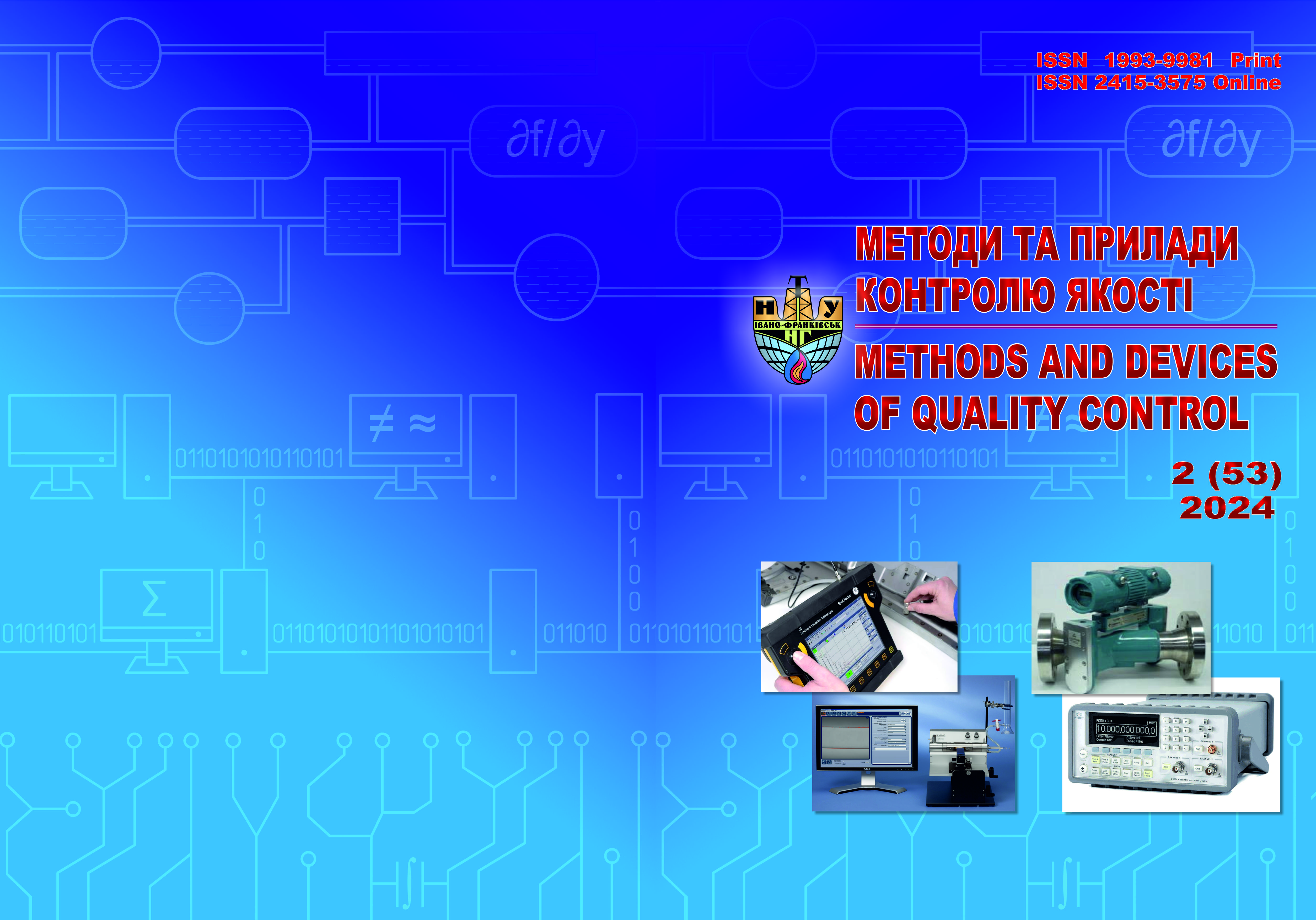ХВИЛЕВІДНІ РІВНЕМІРИ: КАЛІБРУВАННЯ ТА ВПЛИВ УМОВ НАВКОЛИШНЬОГО СЕРЕДОВИЩА
DOI:
https://doi.org/10.31471/1993-9981-2024-2(53)-23-32Ключові слова:
невизначеність вимірювань, калібрування, хвилевідні радарні рівнеміри направленої дії, діелектрична проникністьАнотація
Проведено детальний аналіз невизначеності для хвилеводні радарні рівнеміри, зосереджуючись на схемах калібрування та впливі факторів навколишнього середовища. Хвилеводні радарні рівнеміри широко застосовуються в промисловості, особливо в умовах жорстких експлуатаційних середовищ. Частина таких сенсорів призначена для технологічного контролю і не потребують високого рівня точності, тоді як інші застосування вимагають надвисокого рівня точності. У дослідженні розглянуто вплив факторів навколишнього середовища, таких як температура, тиск і вологість повітря, на точність вимірювань та ефективність калібрування. Проаналізовано компоненти невизначеності включно з похибками еталонних інструментів, випадковими некомпенсованими флуктуаціями результатів вимірювань, нелінійністю функції перетворення та варіативністю діелектричної проникності. Аналіз виконано для еталонних умов і розширеного діапазону умов навколишнього середовища. Результати показують, що невизначеність вимірювань залишається в межах допустимих норм для малих контрольованих відстаней та референсних умов експлуатації. Однак, за умов значної мінливості навколишнього середовища, зміни діелектричної проникності та шуму в оцінці часу значно збільшують загальну невизначеність, особливо для вимірювань на великих відстанях. Наведено практичні рекомендації щодо підтримання точності вимірювань для різних умов експлуатації. У статті наведено порівняння сценаріїв використання високоточних калібрувальних стендів із альтернативами відносно низької вартості, придатними для некритичних застосувань та забезпечення рівня невизначеності типової для технологічного контролю. Такі порівняння є корисними як для виробників сенсорів, так і для метрологічних служб підприємств або регуляторних установ для оптимізації підходів до калібрування, балансуючи між вартістю та продуктивністю. Результати дослідження
підкреслюють важливість компенсації варіативності діелектричної проникності для застосувань зі значними змінами умов експлуатації. Перспективною тематикою подальших досліджень є розробка методів зменшення невизначеності, включно з дослідженням невизначеності за умов введення корекцій. Наведені моделі та висновки є цінними для вдосконалення поліметричних систем, забезпечуючи надійність вимірювань рівня в різноманітних застосуваннях і сприяючи розвитку промислової автоматизації та управління технологічними процесами.
Завантаження
Посилання
Zivenko, A.V., Nakonechniy, A.G., & Motorkin, D.Y. Level measurement principles & sensors. Materialy IX mezinarodni vedecko-prackticka conference “Veda a technologie: krok do budoucnosti - 2013”. 2013.Dil. 28, Technicke vedy, Prague, 85–90.
Zhukov, Yu.D., & Zivenko, O.V. Intelligent polymetric systems industrial appli-cations. Proceedings of the 2nd International Workshop on Information-Communication Technologies & Embedded Systems (ICTES 2020). 2020. Mykolaiv, Ukraine, P. 122–137. Available: https://www.ceur-ws.org/
Vol-2762/paper8.pdf.
Fellner-Feldegg, H. Measurement of dielectrics in the time domain. The Journal of Physical Chemistry. 1969. Vol. 73(3), P. 616–623. DOI: 10.1021/j100723a023
Topp, G.C., Davis, J.L., & Annan, A.P. Electromagnetic determination of soil water content: Measurements in coaxial transmission lines. Water Resources Research. 1980. Vol.16(3), P. 574–582.
Robinson, D.A., & Friedman, S.P. A method for measuring the solid particle permittivity or electrical conductivity of rocks, sediments, and granular materials. Journal of Geophysical Research: Solid Earth. 2003. Vol. 108(B2), 2076. DOI:10.1029/2001JB000691
Nemarich C. P. Time domain reflectometry liquid level sensors. IEEE Instrumentation & Measurement Magazine. 2001. Vol. 4(4). P. 40–44.
Hollywood P.M. TDR level measurement. Measurement & Control. 1997. Vol.31(6). P. 94–98.
Cataldo A., Tarricone L., Attivissimo F., Trotta A. Simultaneous measurement of dielectric properties and levels of liquids using a TDR method. Measurement. 2008. Vol. 41(3), P. 307–319. DOI: 10.1016/j.measurement.2006.11.006
Younglove, B.A. Dielectric constant of compressed gaseous and liquid oxygen. Journal of Research of the National Bureau of Standards - A. Physics and Chemistry. 1972. Vol. 76A(1), P. 1–10.
Huang P.H., Ripple D.C., Moldover M.R., Scace G.E. A reference standard for measuring humidity of air using a re-entrant radio frequency resonator. In Proceedings of the 5th International Symposium on Humidity and Moisture (ISHM 2006). 2006. Rio de Janeiro, Brazil.
Chattopadhyay, R. An empirical formula for computing the dielectric constant of humid air. ResearchGate. 1997. Available: https://www.researchgate.net/publication/262040448.
Santo Zarnik, M., & Belavic, D. An experimental and numerical study of the humidity effect on the stability of a capacitive ceramic pressure sensor. Radioengineering. 2012. Vol. 21(1), P. 201–206.
Zhukov Y.D., Zivenko A.V., Gudyma I.A., Raieva H.N. Correction technique for guided wave radar LPG level measurement sensors. Shipbuilding and Marine Infrastructure. 2019. Vol. 2(12), P. 27–34. DOI: 10.15589/smi2019.2(12).3
Emerson Rosemount. Technical Note: Using Guided Wave Radar for Level in High Pressure Steam Applications. 2019. Available: https://www.emerson.com/
documents/automation/technical-note-using-guided-wave-radar-for-level-in-high-pressure-steam-applications-rosemount-en-76264.pdf.
Chegrinec, V.N. Correction of the transformation function of a level measurement by means of the polymetric information system. Vimiryuvalna ta Obchislyuvalna Tekhnika v Tekhnologichnikh Protsesakh. 2013. Vol. 2. P. 33–38. [in Ukrainian]
International Organization of Legal Metrology (OIML). OIML R 85-1 & 2: Automatic level gauges for measuring the level of liquid in stationary storage tanks. Paris, France: Bureau International de Métrologie Légale (BIML) 2008.
State Primary Standard of the Unit of Length for the Liquid Level. URL: http://www.metrology.kharkov.ua/index.php?id=347&L=2. Accessed: [29.11.2024].
Zivenko O., Nakonechnyi A., Motorkin D., Gudyma E. Automated calibration of level channels in polymetric systems considering the temperature of the electronic unit. Innova-tions in Shipbuilding and Ocean Engineering: Proceedings of the IV International Scientific and Technical Conference, Mykolaiv: National University of Shipbuilding. 2013.
Р. 424–427. [in Ukrainian]
Nakonechnyi A.G., & Zivenko A.V. Automation of calibration of level measurement channels in polymetric systems. Innovations in Shipbuilding and Ocean Engineering, Proceedings of the VI International Scientific and Technical Conference Dedicated to the 95th Anniversary of Admiral Makarov National University of Shipbuilding. Mykolaiv: National University of Shipbuilding. 2015. P. 337–340. [in Ukrainian]
Buck Research Instruments. Buck Research CR-1A User's Manual, Appendix 1. 1996.


.png)




